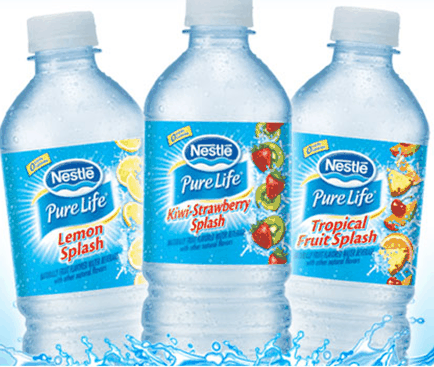
 NESTLE is one of those brands we have all grown up with. One might go as far as to say that its numerous ads and slogans for its vast array of products have become infused in our culture. Certainly, it would be a challenge to find anyone who is unable to connect Kit-Kat with its “Have (/Gimme) a break…” slogan, any child who does not recognize the chocolate-colored Nesquik Bunny or anyone who doesn’t know that it is Coffee Crisp that makes a “nice, light snack.” A company that has extensively developed its product mix, Nestle demonstrates the importance of positioning numerous differentiated products in consumers’ minds. Differentiation by line extension (adding new products to existing lines) and brand extension (creating new product lines) has allowed the company to reach all types of consumers in a way that connects specifically to them and meets their specific needs.
NESTLE is one of those brands we have all grown up with. One might go as far as to say that its numerous ads and slogans for its vast array of products have become infused in our culture. Certainly, it would be a challenge to find anyone who is unable to connect Kit-Kat with its “Have (/Gimme) a break…” slogan, any child who does not recognize the chocolate-colored Nesquik Bunny or anyone who doesn’t know that it is Coffee Crisp that makes a “nice, light snack.” A company that has extensively developed its product mix, Nestle demonstrates the importance of positioning numerous differentiated products in consumers’ minds. Differentiation by line extension (adding new products to existing lines) and brand extension (creating new product lines) has allowed the company to reach all types of consumers in a way that connects specifically to them and meets their specific needs.

The company has created significant depth in its chocolate bar line, for example, by offering Aero, Big Turk, Coffee Crisp, Kit-Kat, Turtles, Rolo, Mack Toffee and Smarties to name a few. Further, it has created designated peanut-free products to appeal to a large number of allergic consumers and slim sizes of many of its chocolate bars for those health conscious consumers. Of course, packaging in the chocolate bar industry is critical and Nestle has done a great job of designing colorful and appealing wrappers, logos and symbols. Moreover, Nestle has extended its brand by offering such varied product lines as Pure Life water, Purina pet food, Power Bar and other sports-nutrition products, Nestea iced-tea, Carnation hot chocolate, Nescafe coffee, dozens of ice-cream products including Haagen Dazs, Drumstick, Parlour, and various Nestle chocolate bar flavors, frozen foods, Nestle Baby baby food and more.

Besides a number of more obvious reasons for a company to develop its product mix such as to increase brand awareness and target a greater number of market segments, I feel that trust is a critical motive. I was having a bit of an argument about this with someone the other day and after hearing her position, I remain firm in my stance. Trust between a consumer and a brand develops either after repeated use of a product or after use of a number of a brand’s different products. This trust leads to loyalty and solidifies a brand’s position within a consumer’s evoked set. I feel that developing one’s product mix causes trust of a brand by a consumer to develop sooner. For example, if a person who comes to expect a certain level of value and quality in one Nestle product and is rarely dissatisfied by the brand decides to try a different product, they are more likely to trust that another Nestle product will deliver and will not waste their dollar. Purchases of Nestle chocolate bars become purchases of Nestle ice-cream and Nestea and possibly influence one’s decision to then buy Purina for their pet. By the time the same person begins a family and is out shopping for baby food, it is their past experience with Nestle and trust for the brand that may influence them to purchase Nestle Baby.
(1).jpg)
Categories: